Page 146 of 473
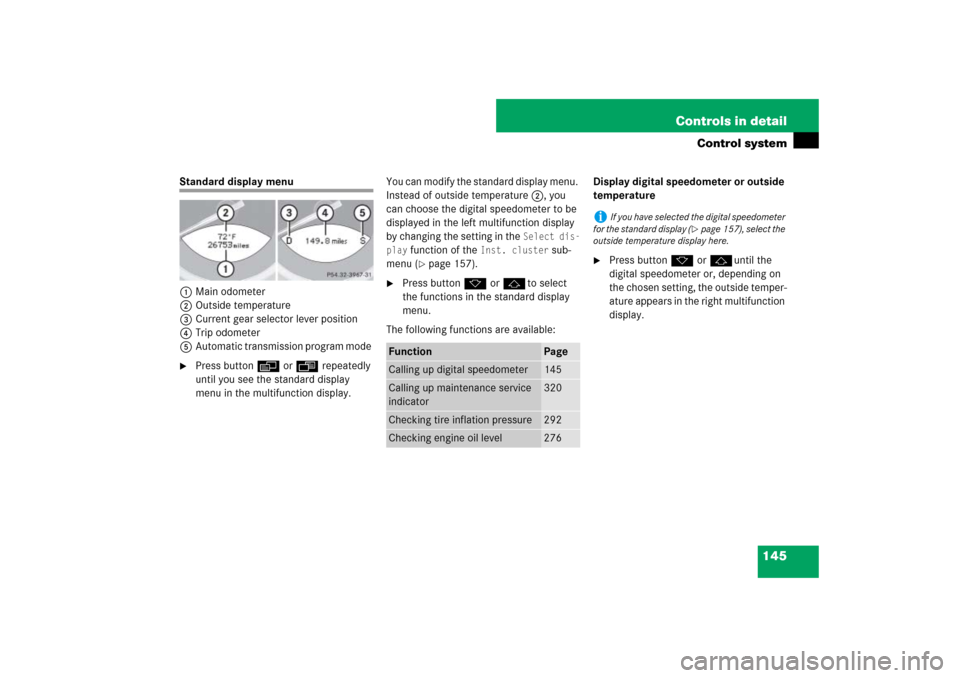
145 Controls in detail
Control system
Standard display menu
1Main odometer
2Outside temperature
3Current gear selector lever position
4Trip odometer
5Automatic transmission program mode �
Press button è or ÿ repeatedly
until you see the standard display
menu in the multifunction display.You can modify the standard display menu.
Instead of outside temperature 2, you
can choose the digital speedometer to be
displayed in the left multifunction display
by changing the setting in the
Select dis-
play
function of the
Inst. cluster
sub-
menu (
�page 157).
�
Press button k or jto select
the functions in the standard display
menu.
The following functions are available:Display digital speedometer or outside
temperature
�
Press button k or juntil the
digital speedometer or, depending on
the chosen setting, the outside temper-
ature appears in the right multifunction
display.
Function
Page
Calling up digital speedometer
145
Calling up maintenance service
indicator
320
Checking tire inflation pressure
292
Checking engine oil level
276
i
If you have selected the digital speedometer
for the standard display (
�page 157), select the
outside temperature display here.
Page 153 of 473

152 Controls in detailControl systemVehicle status message memory menu
Use the vehicle status message memory
menu to scan malfunction and warning
messages that may be stored in the sys-
tem. Such messages appear in the multi-
function display and are based on
conditions or system status the vehicle’s
system has recorded.
The vehicle status message memory menu
only appears, if messages have been
stored.
�
Press button è or ÿ repeatedly
until the vehicle status message mem-
ory menu appears in the multifunction
display.
If the vehicle status message memory
menu does not appear, no messages
have been stored.If conditions have occurred causing status
messages to be recorded, the number of
messages appears in the right multifunc-
tion display:
1Number of recorded status messages
�
Press button k or j.
The stored messages will now be dis-
played in the order in which they have
occurred. For malfunction and warning
messages, see “Vehicle status messag-
es in the multifunction display”
(�page 347).
Warning!
G
Malfunction and warning messages are only
indicated for certain systems and are inten-
tionally not very detailed. The malfunction
and warning messages are simply a remind-
er with respect to the operation of certain
systems and do not replace the owner’s
and/or driver’s responsibility to maintain
the vehicle’s operating safety by having all
required maintenance and safety checks
performed on the vehicle and by bringing
the vehicle to an authorized Mercedes-Benz
Center to address the malfunction and
warning messages (
�page 347).
i
After you have scrolled through all recorded
status messages, the first recorded message ap-
pears again.
Page 258 of 473
257 Operation
The first 1000 miles (1500 km)
Driving instructions
At the gas station
Engine compartment
Tires and wheels
Winter driving
Maintenance
Vehicle care
Page 260 of 473
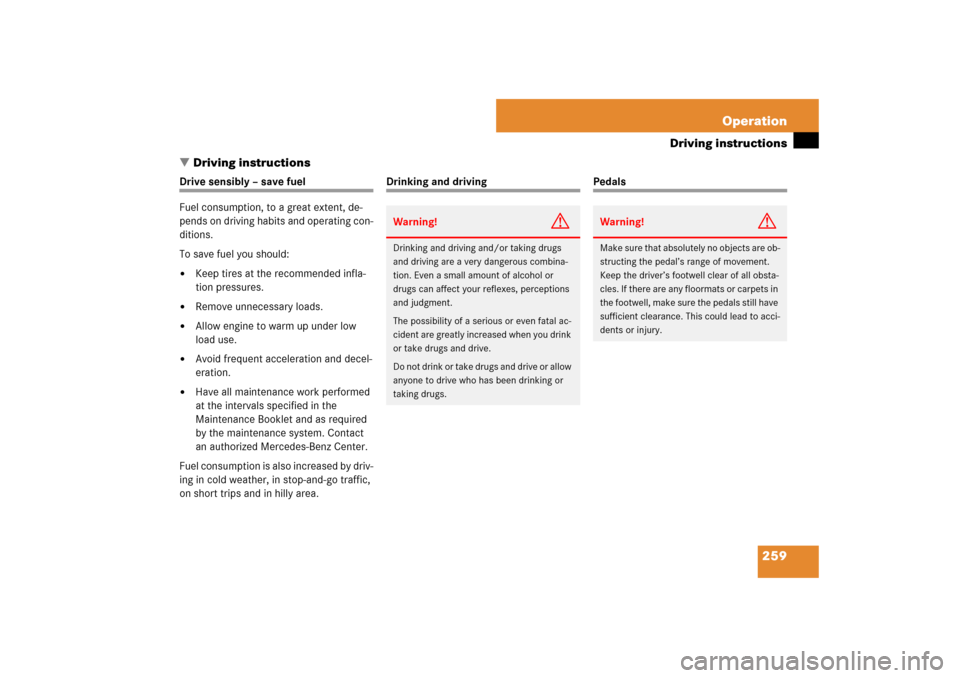
259 Operation
Driving instructions
�Driving instructions
Drive sensibly – save fuel
Fuel consumption, to a great extent, de-
pends on driving habits and operating con-
ditions.
To save fuel you should:�
Keep tires at the recommended infla-
tion pressures.
�
Remove unnecessary loads.
�
Allow engine to warm up under low
load use.
�
Avoid frequent acceleration and decel-
eration.
�
Have all maintenance work performed
at the intervals specified in the
Maintenance Booklet and as required
by the maintenance system. Contact
an authorized Mercedes-Benz Center.
Fuel consumption is also increased by driv-
ing in cold weather, in stop-and-go traffic,
on short trips and in hilly area.
Drinking and driving
Pedals
Warning!
G
Drinking and driving and/or taking drugs
and driving are a very dangerous combina-
tion. Even a small amount of alcohol or
drugs can affect your reflexes, perceptions
and judgment.
The possibility of a serious or even fatal ac-
cident are greatly increased when you drink
or take drugs and drive.
Do not drink or take drugs and drive or allow
anyone to drive who has been drinking or
taking drugs.
Warning!
G
Make sure that absolutely no objects are ob-
structing the pedal’s range of movement.
Keep the driver’s footwell clear of all obsta-
cles. If there are any floormats or carpets in
the footwell, make sure the pedals still have
sufficient clearance. This could lead to acci-
dents or injury.
Page 270 of 473
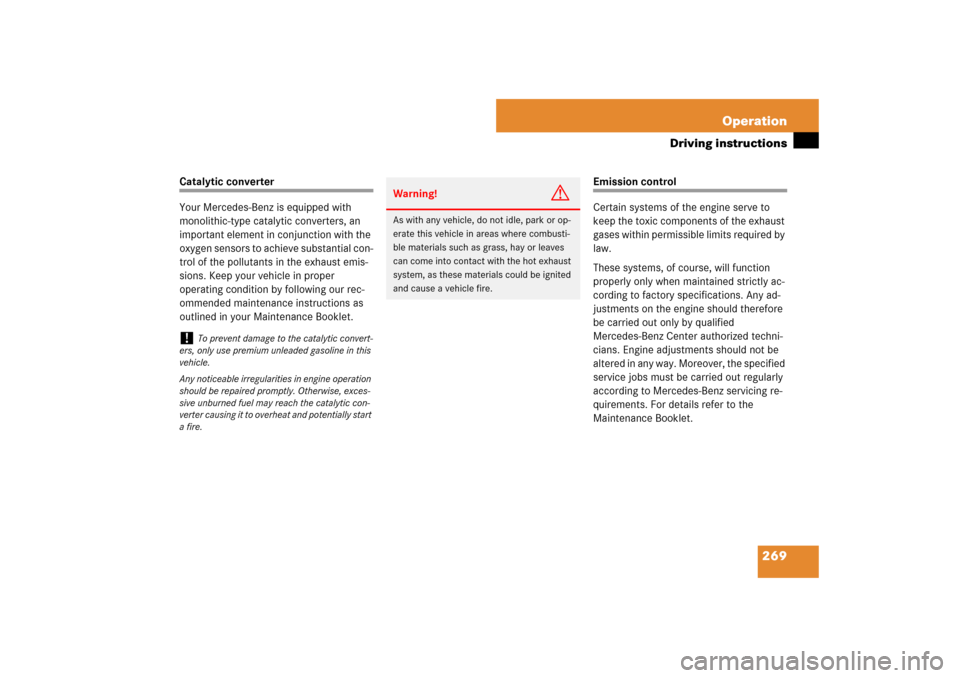
269 Operation
Driving instructions
Catalytic converter
Your Mercedes-Benz is equipped with
monolithic-type catalytic converters, an
important element in conjunction with the
oxygen sensors to achieve substantial con-
trol of the pollutants in the exhaust emis-
sions. Keep your vehicle in proper
operating condition by following our rec-
ommended maintenance instructions as
outlined in your Maintenance Booklet.
Emission control
Certain systems of the engine serve to
keep the toxic components of the exhaust
gases within permissible limits required by
law.
These systems, of course, will function
properly only when maintained strictly ac-
cording to factory specifications. Any ad-
justments on the engine should therefore
be carried out only by qualified
Mercedes-Benz Center authorized techni-
cians. Engine adjustments should not be
altered in any way. Moreover, the specified
service jobs must be carried out regularly
according to Mercedes-Benz servicing re-
quirements. For details refer to the
Maintenance Booklet.
!
To prevent damage to the catalytic convert-
ers, only use premium unleaded gasoline in this
vehicle.
Any noticeable irregularities in engine operation
should be repaired promptly. Otherwise, exces-
sive unburned fuel may reach the catalytic con-
verter causing it to overheat and potentially start
a fire.
Warning!
G
As with any vehicle, do not idle, park or op-
erate this vehicle in areas where combusti-
ble materials such as grass, hay or leaves
can come into contact with the hot exhaust
system, as these materials could be ignited
and cause a vehicle fire.
Page 279 of 473

278 OperationEngine compartmentChecking engine oil level with the oil
dipstick (SL 550 only)
When checking the oil level�
the vehicle must be parked on level
ground
�
the vehicle must have been stationary
for at least 5 minutes with the engine
turned off
1Oil dipstick
2Upper mark
3Lower mark
�
Open the hood (
�page 274).
�
Pull out oil dipstick 1.
�
Wipe oil dipstick 1 clean.
�
Fully insert oil dipstick 1 into the dip-
stick guide tube.
�
Pull out oil dipstick 1 again after ap-
proximately 3 seconds to obtain accu-
rate reading.
The oil level is correct when it is be-
tween lower mark 3 (min.) and upper
mark 2 (max.) of the oil dipstick.
�
If necessary, add engine
oil (
�page 278).
For more information on engine oil, see
“Technical data” section (
�page 444) and
(
�page 446).
For information on messages in the multi-
function display concerning engine oil, see
the “Practical hints” section (
�page 375).Adding engine oil
i
In vehicles without an oil dipstick, the engine
oil level is measured via the control
system (
�page 276).
i
The filling quantity between the upper and
lower marks on the oil dipstick is approximately
2.1 US qt. (2.0 l).
!
Only use approved engine oils and oil filters
required for vehicles with Maintenance System
(U.S. vehicles) or FSS (Canada vehicles). For a
listing of approved engine oils and oil filters, re-
fer to the Factory Approved Service Products
pamphlet in your vehicle literature portfolio, or
contact an authorized Mercedes-Benz Center.
Using engine oils and oil filters of specification
other than those expressly required for the Main-
tenance System (U.S. vehicles) or FSS (Canada
vehicles), or changing of oil and oil filter at
change intervals longer than those called for by
the Maintenance System (U.S. vehicles) or FSS
(Canada vehicles) will result in engine or emis-
sion control system damage not covered by the
Mercedes-Benz Limited Warranty.
Page 282 of 473
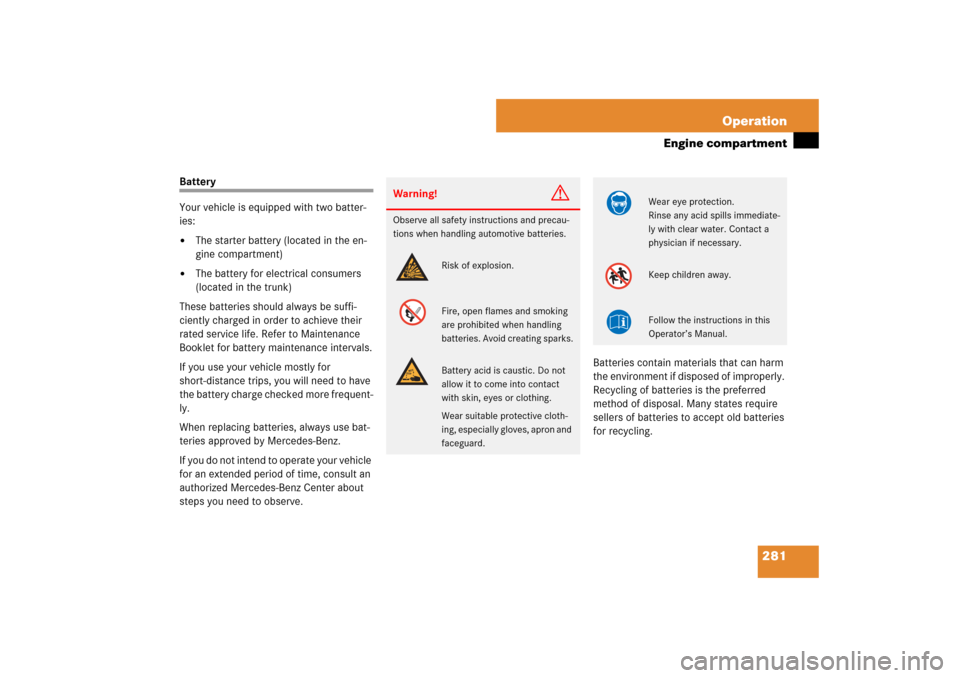
281 Operation
Engine compartment
Battery
Your vehicle is equipped with two batter-
ies:�
The starter battery (located in the en-
gine compartment)
�
The battery for electrical consumers
(located in the trunk)
These batteries should always be suffi-
ciently charged in order to achieve their
rated service life. Refer to Maintenance
Booklet for battery maintenance intervals.
If you use your vehicle mostly for
short-distance trips, you will need to have
the battery charge checked more frequent-
ly.
When replacing batteries, always use bat-
teries approved by Mercedes-Benz.
If you do not intend to operate your vehicle
for an extended period of time, consult an
authorized Mercedes-Benz Center about
steps you need to observe.Batteries contain materials that can harm
the environment if disposed of improperly.
Recycling of batteries is the preferred
method of disposal. Many states require
sellers of batteries to accept old batteries
for recycling.
Warning!
G
Observe all safety instructions and precau-
tions when handling automotive batteries.
Risk of explosion.
Fire, open flames and smoking
are prohibited when handling
batteries. Avoid creating sparks.
Battery acid is caustic. Do not
allow it to come into contact
with skin, eyes or clothing.
Wear suitable protective cloth-
ing, especially gloves, apron and
faceguard.
Wear eye protection.
Rinse any acid spills immediate-
ly with clear water. Contact a
physician if necessary.
Keep children away.
Follow the instructions in this
Operator’s Manual.
Page 285 of 473
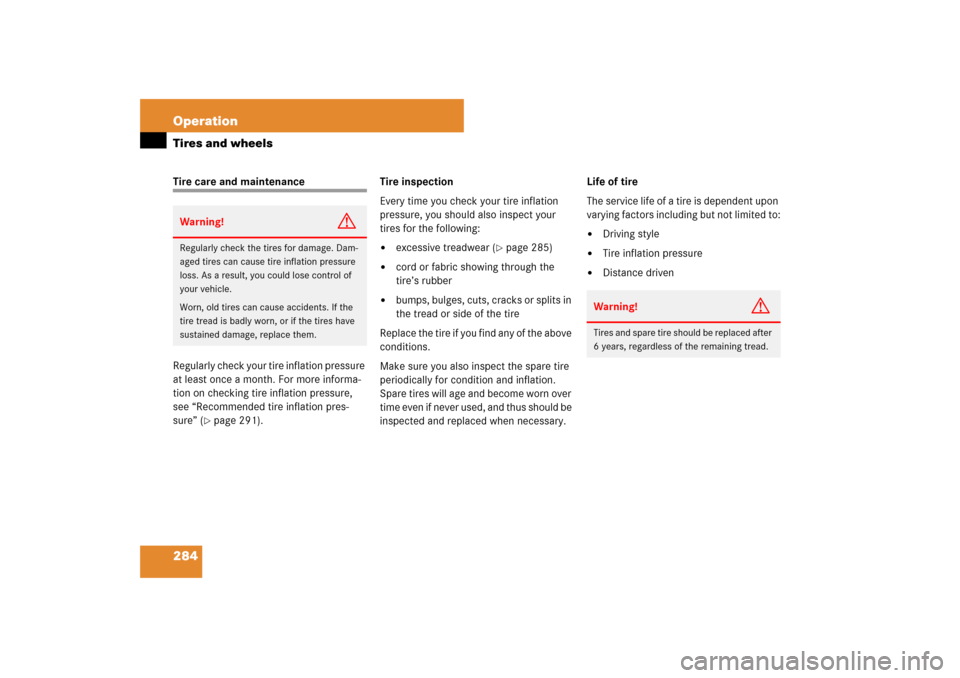
284 OperationTires and wheelsTire care and maintenance
Regularly check your tire inflation pressure
at least once a month. For more informa-
tion on checking tire inflation pressure,
see “Recommended tire inflation pres-
sure” (
�page 291).Tire inspection
Every time you check your tire inflation
pressure, you should also inspect your
tires for the following:
�
excessive treadwear (
�page 285)
�
cord or fabric showing through the
tire’s rubber
�
bumps, bulges, cuts, cracks or splits in
the tread or side of the tire
Replace the tire if you find any of the above
conditions.
Make sure you also inspect the spare tire
periodically for condition and inflation.
Spare tires will age and become worn over
time even if never used, and thus should be
inspected and replaced when necessary.Life of tire
The service life of a tire is dependent upon
varying factors including but not limited to:
�
Driving style
�
Tire inflation pressure
�
Distance driven
Warning!
G
Regularly check the tires for damage. Dam-
aged tires can cause tire inflation pressure
loss. As a result, you could lose control of
your vehicle.
Worn, old tires can cause accidents. If the
tire tread is badly worn, or if the tires have
sustained damage, replace them.
Warning!
G
Tires and spare tire should be replaced after
6 years, regardless of the remaining tread.